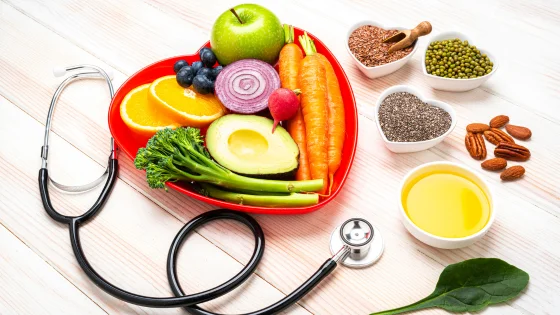Are you looking to improve your health with minimal effort? One of the best ways to do so is by focusing on what you put on your plate. A healthy diet can work wonders for your energy levels, immune system, and overall well-being. In this blog post, we’ll explore the top five nutrient-rich foods to include in your daily meals for optimal health. By incorporating these superfoods into your routine, you’ll be well on your way to a healthier, more vibrant you.
A healthy lifestyle starts with simple dietary changes. By focusing on these superfoods, you can take control of your well-being and prevent a host of chronic illnesses. Let’s dive into why these foods are essential and how you can add them to your diet with ease.
1. Leafy Greens: The Nutrient Powerhouses
When it comes to healthy diet foods, leafy greens top the list. These vegetables are packed with essential vitamins, minerals, and antioxidants that help your body fight disease and maintain overall health.
Why You Should Eat More Leafy Greens
Leafy greens such as spinach, kale, and Swiss chard are loaded with nutrients like vitamin K, vitamin C, iron, and calcium. These nutrients are crucial for maintaining bone health, improving immune function, and preventing chronic diseases.
- Vitamin K supports blood clotting and bone health.
- Vitamin C boosts the immune system and promotes healthy skin.
- Iron is essential for oxygen transportation in the blood.
These superfoods are also incredibly low in calories, making them perfect for anyone looking to maintain or lose weight. Plus, the antioxidants in leafy greens help combat oxidative stress, reducing the risk of developing serious illnesses like cancer and heart disease.
How to Add Leafy Greens to Your Diet
Incorporate leafy greens into your meals by:
- Adding spinach to your morning smoothie.
- Tossing kale into soups or stews.
- Making a colorful salad with Swiss chard.
You can also try sautéing greens with garlic and olive oil for a quick and healthy side dish. Leafy greens are versatile and can be used in a variety of cuisines, from Italian to Asian dishes. The possibilities are endless, and your body will thank you for the added nutrients!
2. Berries: Nature’s Sweet Superfoods
Berries are more than just a tasty treat—they’re some of the healthiest fruits you can eat. Packed with antioxidants, fiber, and vitamins, berries are a must-have in a nutrient-rich diet.
Why Berries Are Superfoods
Berries such as blueberries, strawberries, and raspberries are loaded with antioxidants that help fight inflammation and protect your cells from damage. Additionally, they’re rich in fiber, which aids digestion and promotes heart health.
- Blueberries are known for their high antioxidant content.
- Strawberries provide a healthy dose of vitamin C.
- Raspberries are a great source of dietary fiber.
Regular consumption of berries has been linked to improved brain health and a lower risk of chronic diseases, including heart disease and type 2 diabetes. Their natural sweetness also makes them a healthier alternative to sugary snacks.
Easy Ways to Enjoy Berries
- Add them to your morning oatmeal or yogurt.
- Blend them into a smoothie.
- Snack on them fresh or freeze them for later use.
You can also use berries to make healthy desserts like chia pudding or homemade jam with no added sugars. These tiny fruits pack a powerful punch when it comes to your health.
3. Fatty Fish: Brain and Heart Boosters
Fatty fish like salmon, mackerel, and sardines are some of the healthiest protein sources you can include in your diet. They’re rich in omega-3 fatty acids, which are essential for brain and heart health.
The Benefits of Fatty Fish
Omega-3 fatty acids found in fatty fish help reduce inflammation, lower the risk of heart disease, and support brain function. They also play a crucial role in maintaining healthy eyesight and reducing the risk of age-related macular degeneration.
- Salmon is a popular choice due to its versatility and rich flavor.
- Mackerel is a lesser-known but equally beneficial fish.
- Sardines are budget-friendly and packed with nutrients.
Fatty fish is also an excellent source of high-quality protein, which is essential for muscle maintenance and repair. Additionally, it contains important nutrients like vitamin D, which supports bone health and immune function.
How to Incorporate Fatty Fish
- Grill or bake salmon for a healthy dinner option.
- Add sardines to your salads or toast.
- Include mackerel in your pasta dishes.
You can also make fish tacos or sushi bowls for a fun twist. Your brain and heart will thank you for making fatty fish a staple in your diet.
4. Nuts and Seeds: Tiny Nutrient Powerhouses
Don’t underestimate the power of nuts and seeds. These small but mighty foods are full of healthy fats, protein, and essential nutrients that can help you maintain a balanced diet.
Why Nuts and Seeds Are Essential
Nuts like almonds, walnuts, and cashews, along with seeds such as chia seeds, flaxseeds, and pumpkin seeds, are loaded with healthy fats, fiber, and antioxidants. They’re known to reduce the risk of heart disease and support weight management.
- Almonds are a great source of vitamin E.
- Walnuts provide a healthy dose of omega-3 fatty acids.
- Chia Seeds are packed with fiber and protein.
Nuts and seeds also contain important minerals like magnesium, zinc, and selenium, which are crucial for various bodily functions, including immune support, energy production, and DNA repair.
Ways to Enjoy Nuts and Seeds
- Sprinkle chia seeds on your yogurt or oatmeal.
- Snack on a handful of mixed nuts.
- Use flaxseeds as an egg substitute in baking.
You can also make your own nut butter or seed-based energy bars. These nutrient-rich foods are perfect for anyone looking to improve their overall health.
5. Whole Grains: The Foundation of a Healthy Diet
Whole grains like quinoa, brown rice, and oats are essential for maintaining energy levels and providing your body with important nutrients.
The Importance of Whole Grains
Whole grains are high in fiber, vitamins, and minerals, which help regulate blood sugar levels, support digestion, and keep you feeling full for longer periods. They’re a staple in any healthy diet.
- Quinoa is a complete protein, making it an excellent choice for vegetarians.
- Brown Rice is a healthier alternative to white rice.
- Oats are perfect for a heart-healthy breakfast.
Whole grains also contain phytonutrients and antioxidants that protect your body from harmful free radicals. They contribute to better gut health and can help reduce the risk of certain cancers.
How to Add Whole Grains to Your Diet
- Make quinoa bowls with your favorite vegetables and proteins.
- Swap white rice for brown rice in your meals.
- Enjoy oatmeal topped with berries and nuts.
Try making whole grain salads or using whole grain flour in your baking to increase your intake. Whole grains provide long-lasting energy to fuel your day.
Bonus Tips for a Healthy Diet
In addition to these top five foods, here are some tips to help you stay on track:
- Drink plenty of water to stay hydrated.
- Limit processed foods and added sugars.
- Practice mindful eating to enjoy your meals fully.
- Focus on portion control to avoid overeating.
- Include a variety of colorful fruits and vegetables for a well-rounded diet.
Your Path to Optimal Health
Incorporating these five nutrient-rich foods into your daily diet is a simple yet powerful way to improve your overall health. From leafy greens to whole grains, these superfoods provide essential nutrients that support your body in countless ways. Remember, a healthy diet isn’t about perfection—it’s about making small, sustainable changes that add up over time. Start today and enjoy the benefits of a healthier you!
Embrace the journey to better health with these nutrient-packed choices. Your body will thank you for the care and attention you provide through your meals.


